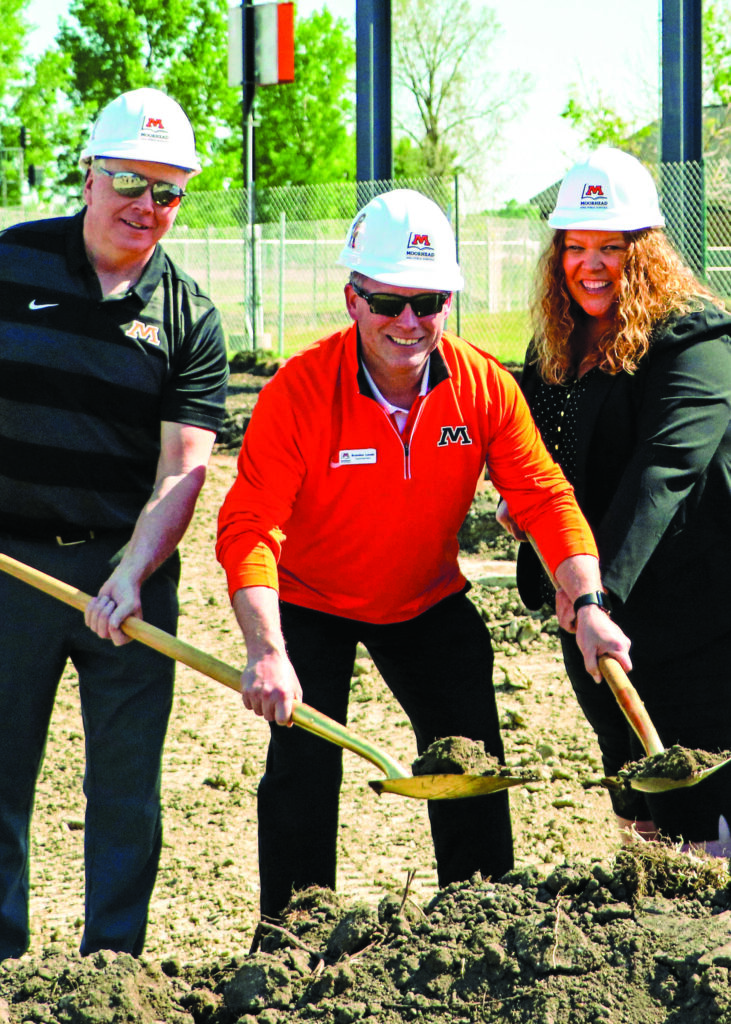
Moorhead High School Principal Dave Lawrence, Superintendent Brandon Lunak and School Board President Cassidy Bjorklund. (Photo/Chelsea Diederich.)
Nancy Edmonds Hanson
Construction projects have been a constant in Brandon Lunak’s life since joining the Moorhead school district in 2014. But this moment still marks a high point.
“It felt like we’ve accomplished something,” the superintendent says of last week’s ground-breaking at the high school site. “The community has spent years planning what secondary education will look like, going forward. But after all those meetings before and during the design phase – all that paper – there’s something special about watching the Caterpillar ripping into the pavement of that parking lot and our leaders digging shovels into the ground.
“Now you know it’s getting real.”
The emerging transformation of secondary education – the new high school and the almost-complete Career Academy – is the crown jewel of a two-decade building program that has readied the Moorhead school district for the challenges of rapid growth and changing demands of the 21st century. It began well before Lunak came from Waubun, Minnesota, in 2014 to take over as assistant superintendent for finance and facilities, and was roaring forward when he succeeded the late Lynne Kovash as superintendent four years later.
But the evolution of the district’s brick-and-mortar facilities still has four or five years before it reaches the goals set over some 20 years ago. “Putting all the pieces together is like a complex jigsaw puzzle. It would be so much easier if everything could all go in order,” he says. “But we’re getting close. When everything is done, this is going to be something to see.”
As the superintendent tells the tale, the current swell of progress began back in 2002, when Moorhead voters narrowly approved a $64 million bond issue. Under Superintendent Larry Nybladh, the district built Horizons Middle School for grades 6 through 8; repurposed Robert Asp and Ellen Hopkins junior high schools into K-5 elementaries; built a fourth K-5 school, S.G. Reinertson Elementary; and added the 9th grade center to Moorhead High.
Many Moorheaders consider that bond-issue vote a turning point. “Some say that Moorhead’s growth was somewhat stagnant at the time,” Lunak observes. “It set off a period of growth that we have been working to keep up with ever since.” Two more major bond issues were approved to fund continued growth, $78 million in 2015 and $110 (for the high school) in 2019.
All in all, Moorhead voters have approved spending more than a quarter billion on building and equipping schools over the past 20 years. Along with that investment has come rapid housing development and population growth. In 2000, Moorhead numbered 32,000 residents. Today, it’s estimated at more than 44,000.
“Growth is good, but it’s a challenge,” Lunak points out. For most of the past decade, the student population has grown more than 200 per year. That means that the city’s four elementary schools are close to bursting at the seams. “Our schools are built for 750 kids or 30 sections,” he explains. “Dorothy Dodds and S.G. Reinertson are both over that, with Asp and Hopkins at or near that number. We’re close to the 3,000 mark.”
Will the solution be another bond referendum? That’s where the “jigsaw puzzle” comes in. By moving programs around the district’s facilities, including the School Operations Center on 30th Avenue South and the Vista Center for Educaiton (formerly Globe University) on 34th Street and I-94, the district is in the process of freeing up Probstfield to return to service as the district’s fifth elementary.
“I don’t want to say we definitely will not have another vote, but we don’t expect to,” he says cautiously. “The challenge is keeping up with growth. The future depends on how that shapes up. There’s a lot of room to build in Horizon Shores on the east side.” Planners use a rule of thumb of 1.6 children added “per roof,” or with each house built; apartment units are figured at one child for every two units.
Nor are buildings the only things that are going up. “We’ve added teachers and staff every year that I have been here,” Lunak reflects. “Keeping up has been quite a challenge. It has been fun to find ways to put all the pieces together.”


